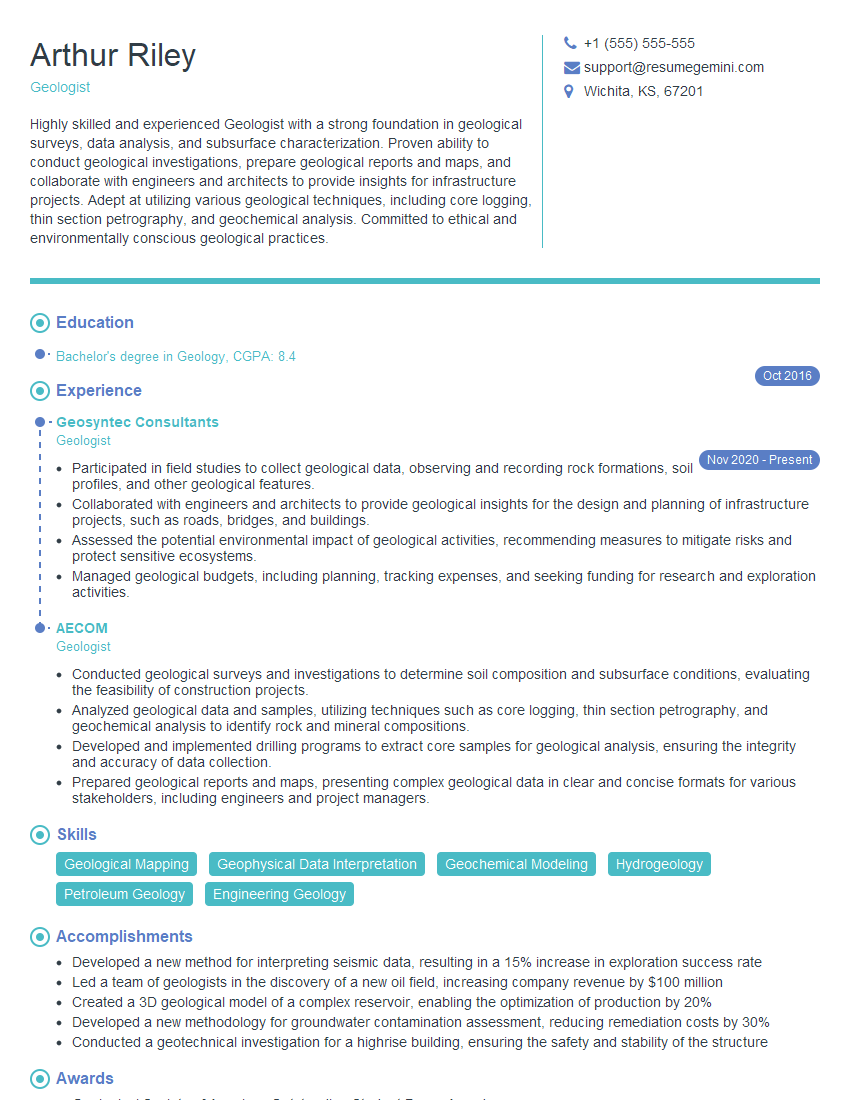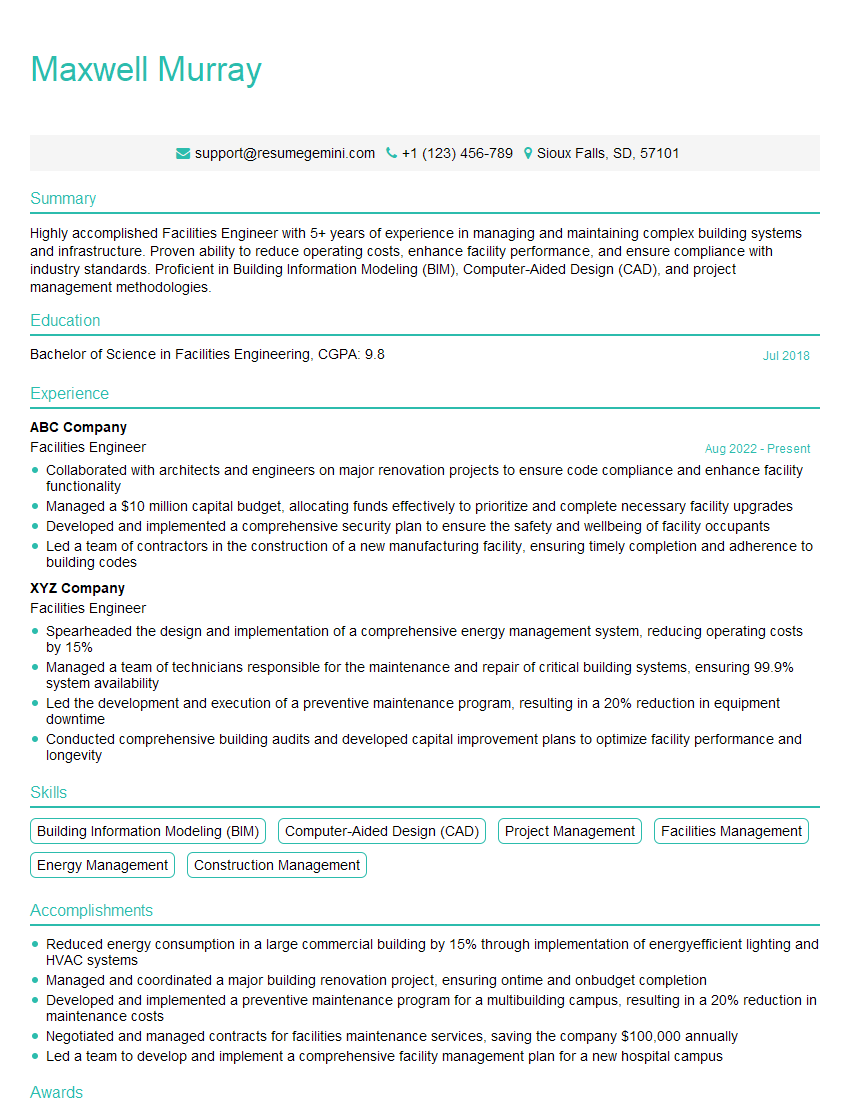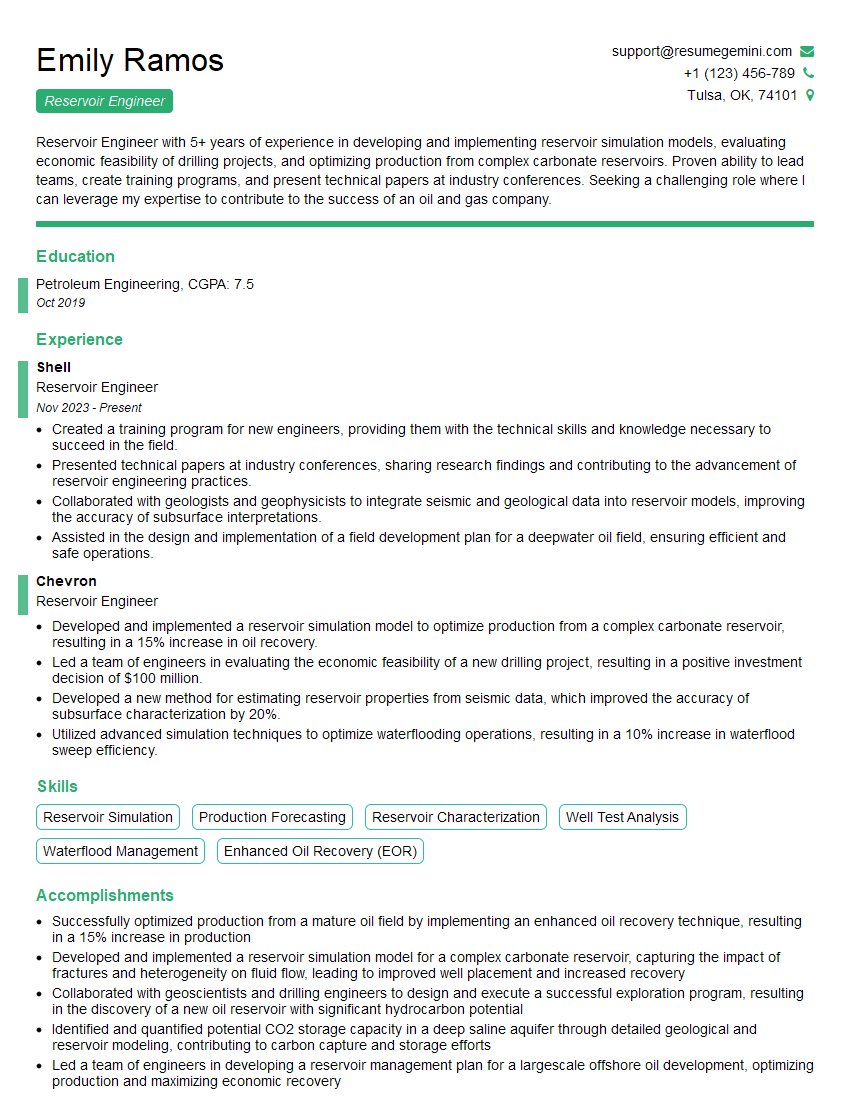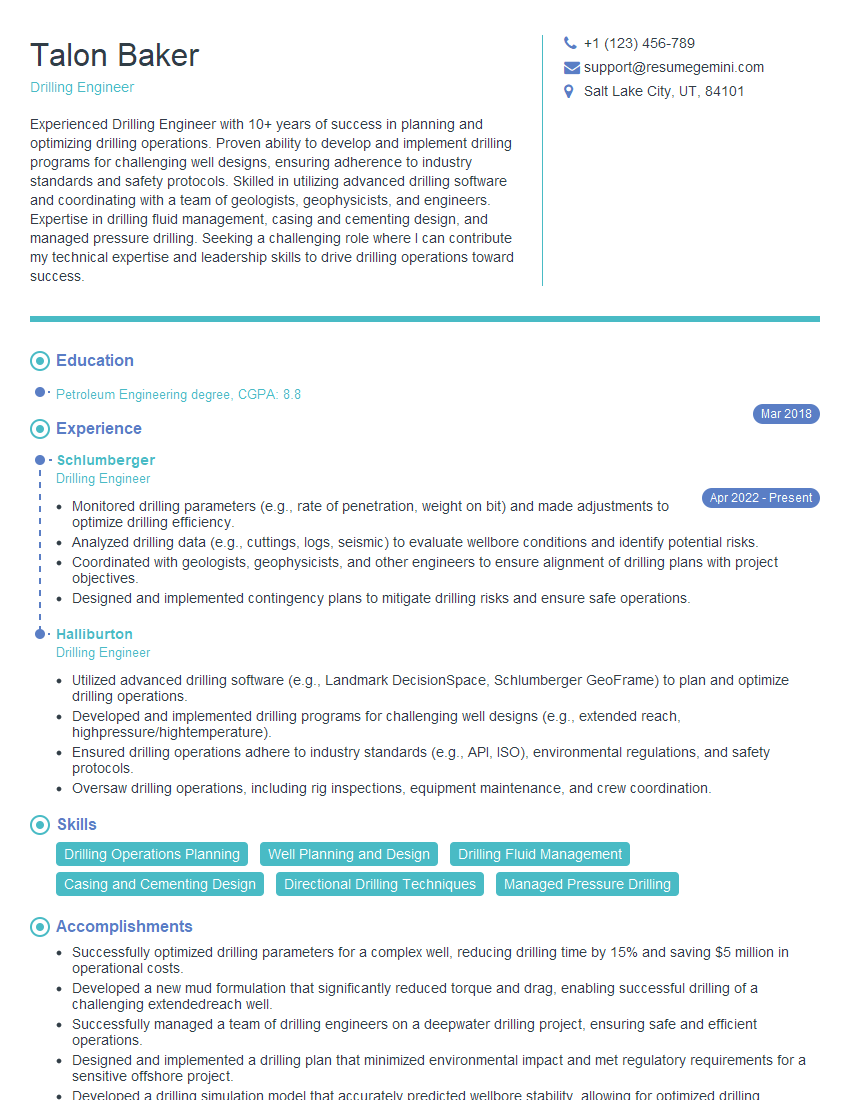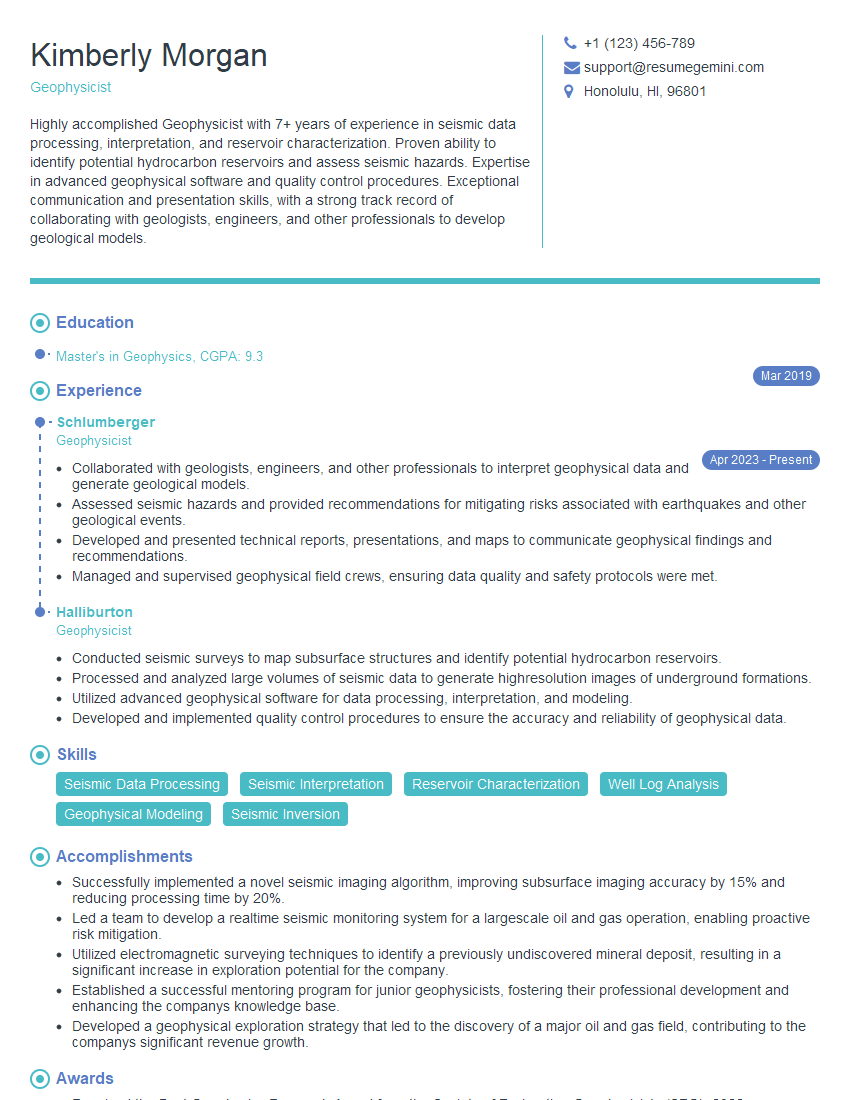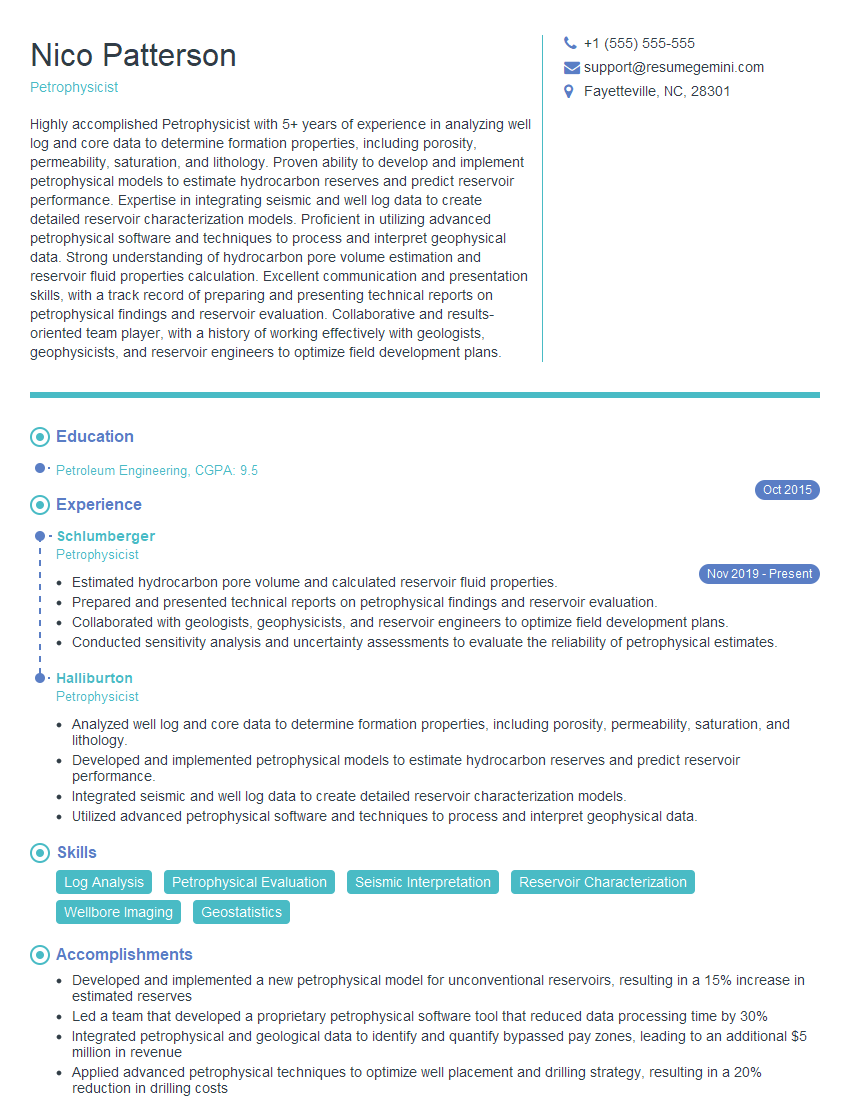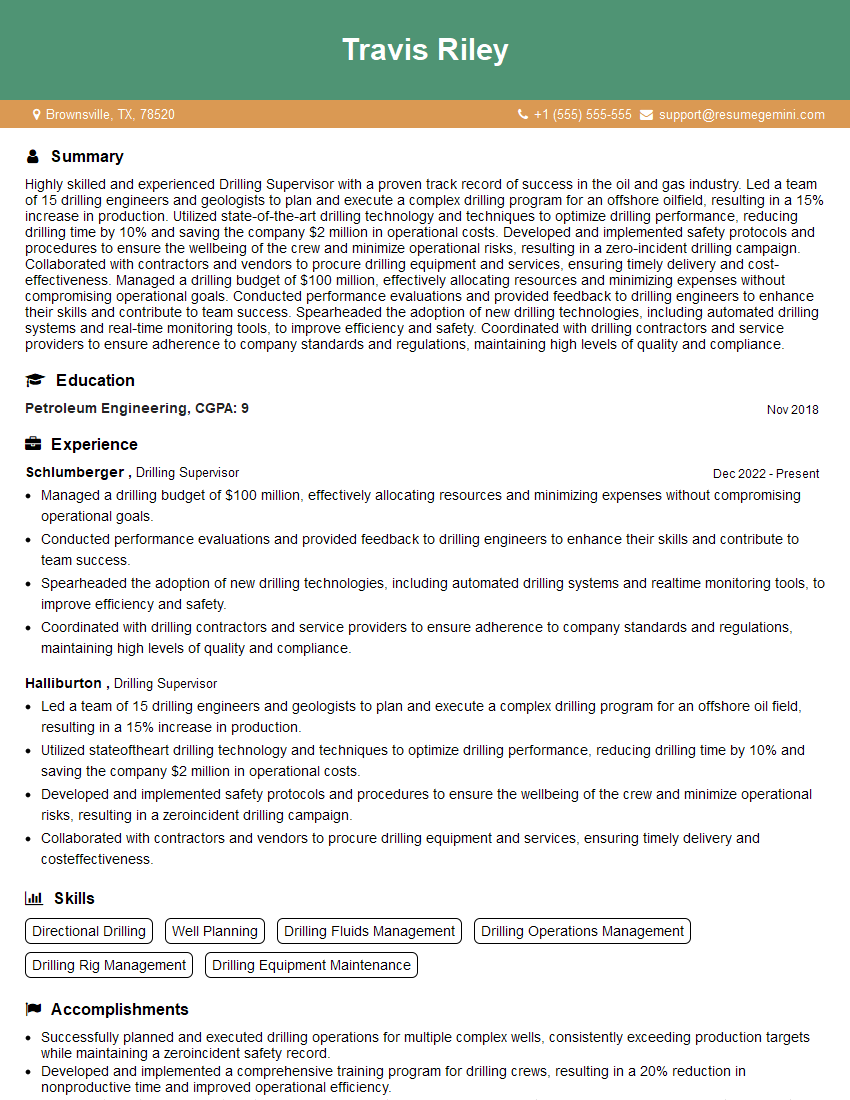Interviews are more than just a Q&A session—they’re a chance to prove your worth. This blog dives into essential Experience in crude oil and natural gas operations interview questions and expert tips to help you align your answers with what hiring managers are looking for. Start preparing to shine!
Questions Asked in Experience in crude oil and natural gas operations Interview
Q 1. Explain the difference between conventional and unconventional oil and gas reservoirs.
The key difference between conventional and unconventional oil and gas reservoirs lies in how the hydrocarbons are trapped and extracted. Conventional reservoirs are characterized by naturally occurring geological structures that allow for the accumulation of hydrocarbons in porous and permeable rock formations, like sandstone or limestone, often capped by an impermeable layer (like shale) that prevents the hydrocarbons from escaping. These reservoirs typically have high porosity and permeability, meaning they have many interconnected pores for oil and gas to flow through, making extraction relatively straightforward using traditional drilling techniques. Think of it like a well-filled sponge where the water (hydrocarbons) can easily be squeezed out.
Unconventional reservoirs, on the other hand, hold hydrocarbons in low-permeability formations such as tight sandstone, shale, or coal beds. The hydrocarbons are often trapped within the rock matrix itself, requiring specialized extraction techniques like hydraulic fracturing (fracking) or horizontal drilling to enhance permeability and release the trapped resources. These reservoirs can hold vast amounts of hydrocarbons, but extracting them is significantly more complex and expensive. Imagine a very tightly packed sponge – you need a lot more effort to get the water out.
In short: Conventional reservoirs are naturally easy to extract from; unconventional reservoirs require advanced technology for extraction.
Q 2. Describe the process of hydraulic fracturing.
Hydraulic fracturing, or fracking, is a well stimulation technique used primarily to extract oil and gas from unconventional reservoirs. The process involves injecting a high-pressure mixture of water, sand, and chemicals into a horizontally drilled wellbore to create fractures in the surrounding shale formation. These fractures increase the permeability of the rock, allowing the trapped hydrocarbons to flow more easily into the wellbore and be extracted.
The process typically starts with drilling a horizontal well and then creating a vertical wellbore at regular intervals to improve access. These intervals are then perfumed to improve the pathway for the fracking fluid. The high-pressure fluid injection creates a network of fractures that are propped open by the sand, which is carried by the fluid during the injection. After the fracturing treatment is complete, the well is allowed to flow, producing hydrocarbons.
It’s crucial to note that the environmental impact of fracking is a subject of ongoing debate, concerning water usage, chemical disposal, and potential induced seismicity.
Q 3. What are the key factors influencing reservoir pressure?
Reservoir pressure is the pressure exerted by the fluids (oil, gas, and water) within a reservoir. Several key factors influence this pressure:
- Hydrostatic Pressure: The pressure exerted by the weight of the overlying fluids. Deeper reservoirs experience higher hydrostatic pressure.
- Gas Cap Pressure: In reservoirs with a gas cap (a layer of gas above the oil), the pressure exerted by the gas significantly impacts the overall reservoir pressure.
- Water Drive: As oil is produced, water encroaches into the reservoir, maintaining pressure. The extent of water drive depends on the aquifer properties (the water-bearing formation).
- Rock Compressibility: As fluids are produced, the reservoir rock compresses, leading to a pressure drop. The degree of compressibility varies between different rock types.
- Temperature: Temperature affects the pressure and density of fluids in the reservoir. Higher temperature usually means higher pressure.
Understanding reservoir pressure is critical for optimizing production, predicting reservoir behavior, and designing efficient extraction strategies. For example, a declining reservoir pressure indicates a reduction in the driving force behind hydrocarbon production, requiring measures to maintain or improve pressure.
Q 4. How do you calculate the reserves of an oil or gas reservoir?
Calculating oil and gas reserves is a complex process involving several steps and estimations. There isn’t one single formula; instead, different methods and volumetric calculations are used depending on the reservoir’s characteristics and data availability. Generally, it involves estimating the following:
- Hydrocarbon in place: This involves determining the reservoir’s volume, porosity (the percentage of pore space in the rock), and hydrocarbon saturation (the fraction of pore space occupied by hydrocarbons). The formula is often expressed as:
Hydrocarbon in place = Area × Thickness × Porosity × Hydrocarbon Saturation × Formation Volume Factor- Recoverable reserves: This calculation accounts for the fraction of hydrocarbon in place that can be economically extracted, considering factors like reservoir pressure, permeability, fluid properties, and production technology. Recoverable reserves are typically expressed as a percentage of hydrocarbons in place, often determined through reservoir simulation studies and production history analysis. This is where factors like recovery factor play a key role. It uses knowledge of the reservoir to predict how much can be actually extracted.
These calculations require extensive geological and engineering data obtained through well logs, seismic surveys, core samples, and production testing. Different types of reserves (proved, probable, possible) are classified based on the level of confidence in the estimation.
Q 5. What are the different types of drilling rigs?
Drilling rigs are categorized based on their mobility and operational characteristics:
- Land Rigs: These are stationary structures used for onshore drilling. They include various types such as:
- Jack-up rigs: These elevate the drilling platform above the ground using legs.
- Mast rigs: These are simpler and less expensive, utilizing a mast structure for hoisting drilling equipment.
- Top-drive rigs: These use a top-drive system to rotate the drill string, offering more precise control and efficiency.
- Offshore Rigs: These are designed for drilling in marine environments:
- Jack-up rigs: Similar to land-based jack-ups but designed for offshore operations.
- Semi-submersible rigs: These float on the water but have submerged pontoons for stability.
- Drill ships: These are mobile vessels capable of drilling in deep waters.
- Floating platforms: These provide a stable platform for drilling in deep-water environments.
The choice of rig depends on the specific drilling location (onshore or offshore), water depth, and the complexity of the well.
Q 6. Explain the concept of well logging and its applications.
Well logging is a crucial technique used in oil and gas exploration and production. It involves recording various parameters while a logging tool is lowered into a wellbore to gather information about the subsurface formations. These tools measure various properties of the formation providing important geological and reservoir information that determines the viability of a well.
Applications of well logging include:
- Formation Evaluation: Determining the porosity, permeability, and fluid saturation of reservoir rocks.
- Reservoir Characterization: Mapping the geometry and properties of the reservoir to optimize production strategies.
- Well Completion Design: Selecting appropriate completion techniques based on the formation properties.
- Production Monitoring: Tracking the reservoir pressure and fluid production over time.
- Identifying Hydrocarbon Zones: Locating zones with hydrocarbons (oil or gas).
Different types of well logs exist, such as resistivity logs (to determine the presence of hydrocarbons), sonic logs (to determine the porosity of the rocks), density logs (determine rock density and porosity), gamma ray logs (to determine the lithology and porosity), and neutron logs (to determine porosity).
Q 7. Describe the different types of well completions.
Well completion refers to the process of preparing a well for production after drilling. The objective is to ensure efficient and safe extraction of hydrocarbons. Various types of well completions exist, tailored to the specific reservoir and well conditions:
- Openhole Completion: The simplest type, where the wellbore is left open, allowing hydrocarbons to flow directly into the wellbore. This is suitable for formations with good natural permeability.
- Cased-hole Completion: The wellbore is lined with a steel casing, and perforations are created to allow hydrocarbon flow. This is more common and provides better wellbore stability and control.
- Gravel Pack Completion: A layer of gravel is placed around the wellbore to prevent sand production and maintain permeability. This is frequently used in formations prone to sand influx.
- Fractured Completion: Hydraulic fracturing is used to enhance permeability in low-permeability formations, as discussed earlier. This can be combined with other completion techniques.
- Horizontal Completion: The wellbore is drilled horizontally through the reservoir, increasing the contact area with the hydrocarbon-bearing zone. This is particularly important in unconventional reservoirs.
- Multi-lateral Completion: Multiple horizontal branches are drilled from a single wellbore to access a wider reservoir area.
The choice of well completion is determined by factors like reservoir characteristics, expected production rate, and wellbore stability. Careful planning and design are crucial for maximizing production efficiency and minimizing risks.
Q 8. What are the common challenges in oil and gas production?
Oil and gas production faces numerous challenges, broadly categorized into geological, operational, and economic factors.
- Geological Challenges: These include reservoir heterogeneity (variations in rock properties), low permeability (difficult flow of hydrocarbons), presence of water or gas in the reservoir (reducing recoverable oil and gas), and complex reservoir geometry making efficient extraction difficult. For example, dealing with fractured shale formations requires specialized drilling and completion techniques.
- Operational Challenges: These encompass equipment failures, production downtime, well integrity issues (leaks or collapses), and managing the complex logistics of remote operations. A significant operational challenge is maintaining consistent production rates while minimizing safety risks and environmental impact.
- Economic Challenges: Fluctuating oil and gas prices are a major economic challenge. Production costs, including drilling, completion, and operating expenses, can significantly impact profitability. Regulatory hurdles, including obtaining permits and complying with environmental regulations, add further complexities. For example, the recent energy price volatility has made project financing more challenging.
Successfully navigating these challenges requires a multi-faceted approach encompassing advanced reservoir characterization techniques, robust operational planning, and effective risk management strategies.
Q 9. How do you manage risks associated with oil and gas operations?
Managing risks in oil and gas operations is paramount for safety, environmental protection, and financial success. A layered approach is usually employed, integrating several strategies:
- Hazard Identification and Risk Assessment: This involves systematically identifying potential hazards (e.g., blowouts, fires, spills) and assessing their likelihood and potential consequences. Tools such as HAZOP (Hazard and Operability Study) and What-If analysis are frequently used.
- Risk Mitigation: Implementing control measures to reduce the likelihood or severity of identified risks. This could include using advanced drilling techniques to prevent blowouts, implementing robust safety protocols, and deploying emergency response plans.
- Emergency Response Planning: Developing detailed plans to handle emergencies, including well control procedures, spill response plans, and evacuation procedures. Regular drills and training are crucial for effective emergency response.
- Insurance and Financial Risk Management: Securing appropriate insurance coverage to protect against financial losses due to accidents or production disruptions. Proper financial planning and forecasting are essential to manage economic risks associated with commodity price volatility and project costs.
- Continuous Monitoring and Improvement: Regularly monitoring operations, analyzing performance data, and implementing corrective actions to prevent future incidents. Lessons learned from past incidents are vital for continuous improvement.
Imagine a scenario where a pipeline is being installed near a sensitive ecological area. A thorough risk assessment would identify potential environmental risks, and mitigation measures such as trenchless pipeline installation and rigorous leak detection systems would be implemented.
Q 10. Explain the importance of reservoir simulation.
Reservoir simulation is a crucial tool used to predict the behavior of a reservoir under various production scenarios. It utilizes mathematical models to represent the complex interactions between fluids (oil, gas, water), rock properties, and production operations.
Its importance stems from several key applications:
- Optimizing Production Strategies: Simulation helps determine the optimal well placement, spacing, and production rates to maximize hydrocarbon recovery. For instance, it can help decide whether to implement waterflooding or other enhanced oil recovery techniques.
- Predicting Reservoir Performance: Accurate predictions of reservoir pressure, fluid flow, and ultimate recovery are essential for investment decisions and production planning.
- Evaluating Different Development Scenarios: Simulation allows engineers to compare various development options (e.g., number of wells, drilling locations, production rates) and select the most efficient and profitable strategy.
- Uncertainty Analysis: By incorporating uncertainties in reservoir properties and operating parameters, simulation can provide a range of possible outcomes, helping managers to quantify and manage risks.
Without reservoir simulation, decisions about reservoir development would be based on less reliable estimations, potentially leading to suboptimal production and financial losses.
Q 11. What are the key parameters used in reservoir characterization?
Reservoir characterization involves determining the physical and geological properties of an oil or gas reservoir. Key parameters include:
- Porosity: The percentage of void space in the rock, which determines how much fluid the reservoir can hold.
- Permeability: The ability of the rock to transmit fluids, affecting the rate of hydrocarbon production.
- Fluid Saturation: The percentage of pore space occupied by oil, gas, or water.
- Rock Compressibility: How much the rock’s volume changes under pressure changes, influencing reservoir pressure behavior.
- Fluid Properties: Density, viscosity, and composition of the oil and gas, impacting flow behavior and recovery.
- Pressure and Temperature: These influence fluid properties and flow behavior within the reservoir.
- Fault and Fracture Systems: These geological features affect fluid flow patterns and can create preferential pathways for hydrocarbon migration.
These parameters are determined using various techniques such as well logging, seismic surveys, core analysis, and pressure testing. Accurate characterization is essential for effective reservoir management and optimized hydrocarbon recovery.
Q 12. Describe your experience with different types of oil and gas pipelines.
My experience encompasses various pipeline types used in oil and gas transportation:
- Gathering Pipelines: These pipelines transport hydrocarbons from individual wells to central processing facilities. They are typically smaller in diameter and lower pressure compared to trunk lines.
- Trunklines or Transmission Pipelines: These larger diameter pipelines transport hydrocarbons over long distances from production areas to refineries, storage facilities, or export terminals. They operate at higher pressures.
- Distribution Pipelines: These pipelines distribute refined products (gasoline, diesel) from refineries to storage terminals and ultimately to consumers.
- Offshore Pipelines: These pipelines transport hydrocarbons from offshore platforms to onshore processing facilities. They are designed to withstand harsh marine environments and are often more complex and expensive to construct and maintain.
I’ve worked on projects involving the design, construction, and operation of both onshore and offshore pipelines, considering factors such as pipe material selection (steel, plastic), pressure rating, and corrosion protection to ensure safe and reliable operation. A project I worked on involved the installation of a subsea pipeline, which required specialized engineering expertise to account for the unique challenges posed by the deep-water environment.
Q 13. Explain the different methods of oil and gas transportation.
Oil and gas transportation involves a combination of methods:
- Pipelines: The most common and efficient method for long-distance transportation, particularly for large volumes of hydrocarbons. Pipelines offer relatively low cost per unit and high safety when properly maintained.
- Tankers (Maritime): Used for transporting crude oil and refined products across oceans and large bodies of water. Tankers are vital for international trade but are subject to weather conditions and geopolitical instability.
- Tank Trucks (Road): Primarily used for shorter distances and smaller volumes, commonly for distributing refined products to consumers.
- Railroads: Increasingly used for transporting crude oil and refined products, particularly in regions with limited pipeline infrastructure. This method also faces regulatory challenges and is influenced by the railroad’s operational capacity.
- Barges (Inland Waterways): Transporting oil and gas along navigable rivers and canals, often supporting pipelines or supplementing road and rail transport.
The choice of transportation method depends on various factors including distance, volume, cost, and environmental considerations. Often, a combination of methods is used to optimize the transportation network.
Q 14. What are the environmental concerns associated with oil and gas operations?
Oil and gas operations pose several significant environmental concerns:
- Greenhouse Gas Emissions: The combustion of fossil fuels releases greenhouse gases, contributing to climate change. Methane leakage during production and transportation is also a major concern, as methane is a potent greenhouse gas.
- Air Pollution: Emissions from oil and gas facilities can include pollutants such as volatile organic compounds (VOCs), nitrogen oxides (NOx), and sulfur dioxide (SO2), harming air quality and human health.
- Water Pollution: Spills of oil and gas, wastewater discharges, and the use of produced water in hydraulic fracturing can contaminate water resources. Proper wastewater treatment and spill prevention are crucial.
- Land Degradation: Exploration and production activities can lead to habitat loss, soil erosion, and changes in land use patterns. Careful site selection and restoration efforts are needed to minimize land degradation.
- Biodiversity Loss: Oil and gas activities can disrupt ecosystems and harm wildlife populations, particularly in sensitive habitats like wetlands and marine environments.
Mitigating these environmental impacts requires a commitment to responsible practices, including reducing emissions through improved technology and operational efficiency, implementing strict environmental monitoring programs, and adhering to environmental regulations.
Q 15. How do you ensure the safety of personnel in oil and gas operations?
Ensuring personnel safety in oil and gas operations is paramount. It’s a multifaceted approach that starts with robust safety training and extends to meticulous risk assessment and mitigation strategies. Think of it like building a safety net with multiple layers of protection.
- Comprehensive Training: All personnel receive extensive training on hazard identification, emergency response procedures (e.g., fire, evacuation, H2S detection), and the safe operation of equipment. This isn’t a one-time event; regular refresher courses and competency assessments are crucial.
- Risk Assessment and Mitigation: Before any operation begins, a thorough risk assessment identifies potential hazards (e.g., explosions, spills, equipment failures). We develop detailed procedures to mitigate these risks, using tools like Job Safety Analyses (JSAs) and Permit-to-Work systems.
- Safety Equipment and Procedures: Providing and enforcing the use of personal protective equipment (PPE), such as hard hats, safety glasses, fire-resistant clothing, and respirators, is non-negotiable. Regular equipment inspections and maintenance are also critical. Safe work practices, such as lockout/tagout procedures for equipment maintenance, are strictly followed.
- Emergency Response Planning: We have comprehensive emergency response plans, including drills and regular testing of emergency equipment. These plans cover everything from evacuations and first aid to spill response and communication protocols. Communication is key; clear and concise procedures ensure everyone knows their role during an emergency.
- Continuous Improvement: Safety isn’t a destination; it’s a journey. Regular safety audits, incident investigations (root cause analysis), and safety meetings foster a culture of continuous improvement. Learning from near misses is as important as learning from incidents.
For example, during my time at [Previous Company Name], we implemented a new safety management system that reduced recordable incidents by 25% in a single year. This involved a combination of enhanced training, improved risk assessment procedures, and a stronger emphasis on employee participation in safety initiatives.
Career Expert Tips:
- Ace those interviews! Prepare effectively by reviewing the Top 50 Most Common Interview Questions on ResumeGemini.
- Navigate your job search with confidence! Explore a wide range of Career Tips on ResumeGemini. Learn about common challenges and recommendations to overcome them.
- Craft the perfect resume! Master the Art of Resume Writing with ResumeGemini’s guide. Showcase your unique qualifications and achievements effectively.
- Don’t miss out on holiday savings! Build your dream resume with ResumeGemini’s ATS optimized templates.
Q 16. Describe your experience with production optimization techniques.
Production optimization is all about maximizing hydrocarbon recovery while minimizing operating costs. It’s a data-driven process that combines engineering expertise with advanced analytical techniques.
- Data Analysis: We leverage production data (flow rates, pressures, compositions) to identify bottlenecks and areas for improvement. This involves using sophisticated software to model reservoir performance and predict future production.
- Reservoir Management: Optimizing reservoir performance often involves techniques like waterflooding or gas injection to improve sweep efficiency and increase recovery rates. Understanding reservoir dynamics is crucial for effective management.
- Artificial Lift Optimization: Selecting and optimizing artificial lift methods (e.g., ESPs, gas lift) is crucial in many fields. Regular monitoring and adjustments of artificial lift systems can significantly improve production.
- Well Testing and Intervention: Regular well testing helps diagnose problems and guide interventions, such as acidizing or stimulation treatments, to restore or enhance well productivity.
- Process Optimization: Streamlining production processes, including flow assurance (managing hydrate formation, wax deposition), can minimize downtime and improve efficiency.
In a previous role, I led a project to optimize the production from a mature oil field. By implementing a combination of waterflood optimization and artificial lift improvements, we increased oil production by 15% and reduced operating costs by 10%. This involved detailed reservoir simulation, field testing, and close collaboration with operations personnel.
Q 17. Explain the concept of artificial lift in oil and gas production.
Artificial lift is used when the natural reservoir pressure is insufficient to lift hydrocarbons to the surface at an economical rate. Think of it as giving the oil and gas a helping hand to reach the surface. Several methods exist, each with its own advantages and disadvantages.
- Electrical Submersible Pumps (ESPs): These pumps are submerged in the wellbore and use electricity to lift fluids. They are effective in a wide range of conditions but require reliable power supply and can be susceptible to scaling and sand erosion.
- Gas Lift: This method uses high-pressure gas injected into the wellbore to reduce the hydrostatic pressure and lift the hydrocarbons. It’s relatively simple but requires a readily available gas source and can be less efficient in certain conditions.
- Progressive Cavity Pumps (PCP): These pumps use a rotating helical rotor to move fluids. They are effective in handling viscous fluids and are often used in heavy oil production.
- Rod Pumps: A traditional method using a surface-driven rod string to operate a subsurface pump. They are relatively simple but have lower lift capacity compared to other methods.
The choice of artificial lift method depends on several factors, including reservoir characteristics (pressure, fluid properties), well geometry, and operating costs. For instance, in a high-temperature, high-pressure well, an ESP might be the most suitable option, while gas lift might be more appropriate for a low-pressure, gas-rich reservoir.
Q 18. What are the different types of gas processing plants?
Gas processing plants are crucial for treating raw natural gas, removing impurities, and preparing it for pipeline transportation or further processing. Different types of plants are designed to handle varying gas compositions and processing requirements.
- Sweetening Plants: These plants primarily remove acid gases, such as hydrogen sulfide (H2S) and carbon dioxide (CO2), which are corrosive and harmful. Common processes include amine treating and Claus sulfur recovery.
- Dehydration Plants: These plants remove water vapor from the gas stream, preventing hydrate formation and corrosion in pipelines and downstream processing units. Common methods include glycol dehydration and adsorption.
- Liquefied Natural Gas (LNG) Plants: These plants cool natural gas to cryogenic temperatures, converting it into a liquid for easier transportation and storage. This requires complex refrigeration systems.
- Natural Gas Liquids (NGL) Extraction Plants: These plants separate NGLs (ethane, propane, butane) from the natural gas stream. This involves fractionation, using cryogenic distillation or absorption.
- Helium Extraction Plants: These specialized plants recover helium from natural gas, a valuable and increasingly scarce resource.
The design and size of a gas processing plant depend on the specific composition of the feed gas and the desired product specifications. For instance, a plant processing gas with high levels of H2S would require a more extensive sweetening unit compared to a plant processing relatively sweet gas.
Q 19. Describe your experience with oil and gas field automation.
Oil and gas field automation has revolutionized the industry, improving safety, efficiency, and production optimization. It involves the integration of sensors, control systems, and data analytics to automate various aspects of field operations.
- Supervisory Control and Data Acquisition (SCADA) Systems: These systems monitor and control critical parameters like pressure, temperature, and flow rates from a central location. Real-time data visualization allows operators to identify and respond to problems quickly.
- Remote Monitoring and Control: Automation enables remote monitoring and control of wellheads, pipelines, and processing facilities, improving efficiency and reducing the need for on-site personnel in hazardous areas.
- Predictive Maintenance: Data analytics helps predict equipment failures, allowing for proactive maintenance and preventing costly downtime. This reduces operational risk and extends the life of equipment.
- Automated Well Testing: Automated systems can perform well tests more efficiently and safely, gathering valuable data for production optimization.
- Robotics and Autonomous Systems: Emerging technologies like autonomous robots are increasingly used for inspections, maintenance, and even well intervention, further enhancing safety and efficiency.
During my experience at [Previous Company Name], I was part of a team that implemented a new SCADA system for a large offshore platform. This resulted in a significant reduction in operational costs and improved safety by reducing the need for manual intervention in hazardous areas. The system also provided valuable real-time data for production optimization.
Q 20. Explain your understanding of production allocation and metering.
Production allocation and metering are critical for accurately determining the ownership and quantity of hydrocarbons produced from a field, particularly in shared resources or joint ventures. It’s like dividing the spoils fairly among multiple stakeholders.
- Metering Systems: Accurate metering is achieved using flow meters (e.g., orifice plates, turbine meters) installed in pipelines to measure the volume and composition of produced fluids. Regular calibration and maintenance are crucial for accurate measurement.
- Allocation Methods: Different allocation methods exist, including those based on well testing, reservoir simulation, or production history. The chosen method depends on the complexity of the reservoir and the ownership agreements.
- Data Management and Reporting: Production data from various metering points is collected, processed, and analyzed to generate reports that reconcile production with ownership shares. This requires robust data management systems and quality control procedures.
- Dispute Resolution: Occasionally, discrepancies may arise in production allocation. Clear and transparent processes are needed to resolve disputes among stakeholders, often involving independent verification and arbitration.
- Regulatory Compliance: Accurate allocation and metering are crucial for complying with regulatory requirements and reporting to government agencies.
I’ve been involved in several projects involving production allocation, resolving discrepancies by analyzing metering data, conducting independent well tests, and collaborating with stakeholders to ensure fair and accurate allocation. Accurate allocation is critical for maintaining good relationships between joint venture partners and avoiding costly disputes.
Q 21. What is your experience with different types of drilling fluids?
Drilling fluids, also known as muds, are essential for drilling oil and gas wells. They perform many vital functions, from lubricating the drill bit to carrying cuttings to the surface. The choice of mud depends on various factors, including the formation’s properties and the drilling environment.
- Water-Based Muds: These are the most common type, utilizing water as the base fluid. They can be further classified based on additives used to control properties like viscosity and density.
- Oil-Based Muds: These use oil as the base fluid, providing better lubrication and stability in challenging formations. They are less environmentally friendly than water-based muds and often require special handling.
- Synthetic-Based Muds: These use synthetic oils as the base fluid, offering many benefits of oil-based muds with a lower environmental impact. They are more expensive but are often preferred for sensitive environments.
- Air or Gas Drilling: In some cases, air or gas is used instead of liquid mud. This is often used in shallower wells or formations where water can cause problems.
Choosing the right drilling fluid is critical for successful drilling operations. For instance, in a shale formation prone to swelling, a water-based mud with specific clay inhibitors would be necessary. In a high-pressure, high-temperature well, an oil-based mud or synthetic-based mud might be chosen for improved stability and lubrication. Proper mud management, including regular monitoring and adjustments, is critical throughout the drilling operation to ensure wellbore stability and efficient drilling.
Q 22. Describe your experience with pressure testing and well integrity.
Pressure testing and well integrity are critical for ensuring the safe and efficient operation of oil and gas wells. Pressure testing involves subjecting well components to controlled pressure to identify weaknesses or potential leaks. Well integrity, on the other hand, encompasses the overall condition of the wellbore, casing, and cement, ensuring it can contain the formation fluids and prevent environmental contamination.
My experience spans various pressure testing methods, including hydrostatic testing (filling the wellbore with a fluid column to check for leaks), pneumatic testing (using compressed air), and formation integrity tests (FITs) to assess the strength of the reservoir rock. I’ve worked on both onshore and offshore projects, using different testing protocols according to API standards and specific well conditions. For instance, during a recent project, we discovered a small leak in the casing using hydrostatic testing, which was subsequently repaired before resuming production, preventing a potential environmental incident and significant financial losses.
Maintaining well integrity involves regular monitoring, including pressure monitoring, temperature surveys, and cement bond logs. Any anomalies detected trigger further investigation and potential remedial actions such as cement squeeze operations or casing repairs. I’ve been directly involved in troubleshooting well integrity issues, identifying root causes, and implementing effective solutions. This includes collaborating with multi-disciplinary teams, including engineers, geologists, and operations personnel, to develop and implement cost-effective strategies that maintain well integrity and safety.
Q 23. How do you handle emergencies in an oil and gas operation?
Emergency response in oil and gas operations requires a structured and well-rehearsed approach. The key is to have a well-defined emergency response plan (ERP) and to conduct regular drills to ensure that everyone understands their roles and responsibilities.
My experience involves handling various emergencies, ranging from minor equipment failures to major incidents like well control events or pipeline leaks. In these situations, my primary focus is on ensuring the safety of personnel and protecting the environment. This involves immediately activating the ERP, contacting relevant authorities (e.g., emergency services, regulatory bodies), and coordinating the response team.
- Immediate Actions: Secure the area, shut down affected equipment, and initiate emergency shut-down procedures.
- Damage Control: Contain the spill or leak, and prevent further damage.
- Personnel Safety: Evacuate personnel from the danger zone and provide medical attention if needed.
- Communication: Maintain clear communication with the response team and keep stakeholders informed.
- Post-Incident Investigation: Conduct a thorough investigation to determine the root cause of the incident, to identify improvements to preventative measures and avoid future occurrences.
For example, during a well control incident, I successfully led the team in activating the kill system, containing the well blowout, and preventing a potential environmental catastrophe. This involved quick thinking, clear communication, and close collaboration with well control specialists. After the event, we conducted a detailed investigation, which led to changes in our well control procedures and improved safety protocols.
Q 24. What is your experience with regulatory compliance in the oil and gas industry?
Regulatory compliance is paramount in the oil and gas industry. I have extensive experience in navigating the complex regulatory landscape, ensuring all operations comply with relevant federal, state, and local regulations, along with company internal standards. My knowledge covers a wide range of regulations, including those pertaining to safety, environmental protection, and operational procedures.
This includes maintaining accurate records and reporting, preparing and submitting permit applications, conducting regular inspections and audits, and staying up-to-date with any changes in regulations. I have worked closely with regulatory agencies (such as the EPA and OSHA) and have actively participated in compliance audits, addressing any non-compliances promptly and efficiently. I understand the significance of strict adherence to regulations to maintain a safe and environmentally responsible operation, avoiding potential fines, penalties, and reputational damage.
For instance, I was instrumental in securing the necessary permits for a new drilling project, ensuring all environmental impact assessments were conducted and approved. This involved working closely with environmental consultants and regulatory agencies, ultimately ensuring the project’s compliance with all relevant regulations.
Q 25. Describe your experience using specialized software for oil and gas operations (e.g., Petrel, Eclipse).
I’m proficient in several specialized software packages commonly used in oil and gas operations, including Petrel and Eclipse. Petrel is a powerful reservoir modeling and simulation software used for geological interpretation, reservoir characterization, and production forecasting. I’ve extensively used Petrel to build and interpret 3D geological models, create reservoir simulation workflows, and optimize drilling and completion strategies. I can use it to generate maps, analyze seismic data, and integrate well log data, improving decision-making in reservoir management.
Eclipse, on the other hand, is a sophisticated reservoir simulator that helps predict reservoir behavior under various scenarios. I have leveraged Eclipse to model reservoir fluid flow, predict production performance, and evaluate the effectiveness of different EOR techniques. This involves defining reservoir properties, setting up simulation models, running simulations, and interpreting the results to guide reservoir management decisions. For example, using Eclipse, I helped optimize the injection rates for a waterflood project, leading to increased oil recovery and improved project economics.
I’m also familiar with other software such as OFM (Oilfield Manager), which helps manage the operational side of oil and gas production, tracking well performance, and providing critical data for decision-making.
Q 26. Explain the concept of Enhanced Oil Recovery (EOR).
Enhanced Oil Recovery (EOR) refers to techniques used to increase the amount of oil that can be extracted from a reservoir after primary and secondary recovery methods have been depleted. Primary recovery utilizes the natural reservoir pressure to force oil to the surface. Secondary recovery methods, like waterflooding, inject water to maintain pressure and displace oil. EOR techniques aim to extract the remaining oil, often trapped in the pore spaces of reservoir rocks, enhancing the overall recovery factor.
Several EOR methods exist, each with its own principles and applications:
- Thermal Recovery: This involves heating the reservoir to reduce oil viscosity and improve its flow. Methods include steam injection and in-situ combustion.
- Chemical Injection: Chemicals are injected to alter the oil-water interfacial tension or improve the mobility of the oil. Examples include polymer flooding (improving water sweep efficiency) and surfactant flooding (reducing interfacial tension).
- Gas Injection: This involves injecting gases like CO2 or nitrogen into the reservoir to improve oil mobility and displacement efficiency. CO2 injection is particularly effective because it increases reservoir pressure and improves oil solubility, aiding in its extraction.
The selection of the most appropriate EOR method depends on several factors, including reservoir characteristics (rock type, permeability, oil viscosity), economic considerations, and environmental regulations. For example, in a high-viscosity oil reservoir, steam injection might be the most effective technique. However, in environmentally sensitive areas, the use of CO2 might be preferred due to its lower environmental impact.
Q 27. What are the different methods for gas dehydration?
Gas dehydration is the process of removing water vapor from natural gas. Water in natural gas can cause several problems, including corrosion of pipelines and equipment, formation of hydrates (ice-like plugs that can block pipelines), and reduced heating value of the gas.
Several methods are used for gas dehydration, each with varying levels of efficiency and cost:
- Glycol Dehydration: This is the most common method, using a desiccant (typically triethylene glycol or TEG) to absorb water vapor from the gas. The glycol is then regenerated by heating to remove the absorbed water. This is an efficient process and adaptable to various gas compositions.
- Membrane Dehydration: This method utilizes semi-permeable membranes to selectively separate water vapor from the gas stream. This approach is particularly effective for smaller gas volumes or remote locations.
- Refrigeration Dehydration: This involves cooling the gas to a temperature below the dew point of water, causing condensation and removal of the liquid water. This method is often combined with other dehydration techniques to achieve the required water content.
- Adsorption Dehydration: This uses solid desiccants, such as activated alumina or silica gel, to adsorb water from the gas stream. This is commonly used for smaller-scale applications or specialized situations requiring ultra-dry gas.
The choice of dehydration method depends on several factors, including the required gas dew point, gas flow rate, and cost considerations. For example, in large-scale gas processing plants, glycol dehydration is usually the preferred method due to its efficiency and cost-effectiveness.
Q 28. How do you optimize production in a mature field?
Optimizing production in a mature field presents unique challenges, as reservoir pressure declines and oil becomes more difficult to extract. Strategies focus on maximizing recovery from existing wells and identifying opportunities for improved efficiency.
Several approaches can be employed:
- Improved Waterflooding Management: Optimizing water injection rates and patterns to improve sweep efficiency and displace remaining oil. This could involve using advanced reservoir simulation techniques to guide injection strategies. Analyzing historical injection data and adjusting accordingly is very effective.
- Well Intervention and Workovers: Conducting interventions to address issues such as scale buildup, water coning, or sand production. This might involve acidizing, stimulating, or re-completing wells to restore or improve their productivity. Using downhole tools to pinpoint and treat specific issues can significantly increase output.
- Artificial Lift Optimization: Implementing or optimizing artificial lift systems (e.g., ESPs, gas lift) to enhance oil production from low-pressure wells. Careful consideration must be given to the best methodology based on well characteristics and costs.
- Data Analytics and Reservoir Surveillance: Using advanced analytics and reservoir simulation to monitor reservoir performance, identify production bottlenecks, and optimize operations. Real-time monitoring of production data can indicate immediate changes that need to be addressed. Predictive modeling also helps to anticipate future challenges and proactively implement solutions.
- EOR Techniques: Considering the implementation of EOR techniques (as described previously) to recover additional oil. This may involve cost-benefit analysis and long term planning.
Successfully optimizing production in a mature field often requires a multi-faceted approach, combining several of these strategies to achieve the maximum recovery while maintaining operational efficiency and minimizing costs. For example, in one mature field I worked on, we implemented a comprehensive optimization plan that included improved waterflooding, well workovers, and data analytics, resulting in a significant increase in production.
Key Topics to Learn for Crude Oil and Natural Gas Operations Interviews
- Upstream Operations: Exploration and production techniques, reservoir engineering principles (including reservoir simulation and pressure prediction), drilling operations (directional drilling, well completion), production optimization, and well testing methodologies.
- Midstream Operations: Gathering, processing, storage, and transportation of crude oil and natural gas. Understanding pipeline operations, compressor stations, and processing plants (fractionation, dehydration, etc.) is crucial. Practical application includes analyzing pipeline capacity and optimization strategies.
- Downstream Operations: Refining, marketing, and distribution of petroleum products. Familiarity with refinery processes (fractional distillation, catalytic cracking), product blending, and logistics is beneficial. Problem-solving might involve optimizing refinery throughput or managing product distribution networks.
- Health, Safety, and Environment (HSE): Understanding and applying HSE regulations and best practices in oil and gas operations. This includes risk assessment, emergency response planning, and environmental impact mitigation. Practical application includes analyzing HSE data to identify trends and implement preventative measures.
- Project Management in Oil and Gas: Planning, execution, monitoring, and closure of oil and gas projects. Understanding project scheduling, budgeting, and risk management techniques. Problem-solving may involve resolving project delays or cost overruns.
- Data Analysis and Interpretation: Proficiency in analyzing production data, well logs, and other relevant datasets to optimize operations and make informed decisions. This includes using software for data visualization and statistical analysis.
Next Steps
Mastering the intricacies of crude oil and natural gas operations is paramount for career advancement in this dynamic industry. A strong understanding of these concepts will significantly enhance your interview performance and open doors to exciting opportunities. To maximize your job prospects, it’s crucial to present your experience effectively. Creating an ATS-friendly resume is key to getting your application noticed by recruiters. We strongly encourage you to leverage ResumeGemini, a trusted resource for building professional and impactful resumes. ResumeGemini offers examples of resumes tailored specifically to the oil and gas industry, ensuring your qualifications shine through. Take advantage of these resources to build a resume that accurately reflects your skills and experience and sets you apart from the competition.
Explore more articles
Users Rating of Our Blogs
Share Your Experience
We value your feedback! Please rate our content and share your thoughts (optional).
What Readers Say About Our Blog
This was kind of a unique content I found around the specialized skills. Very helpful questions and good detailed answers.
Very Helpful blog, thank you Interviewgemini team.




